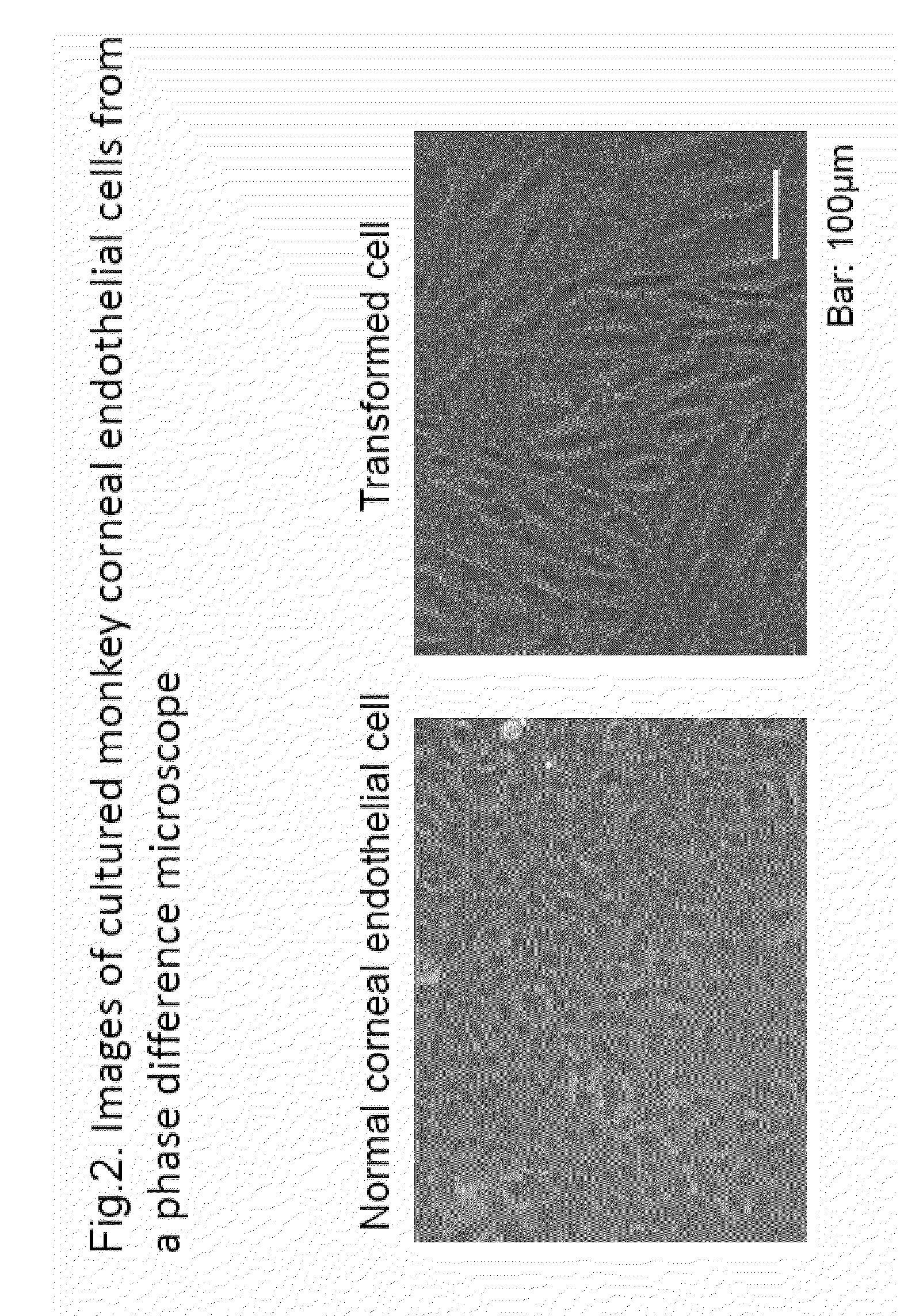Corneal endothelial cell marker
a corneal endothelial cell and marker technology, applied in the cell field, can solve the problems of corneal endothelial cell number decline, corneal endothelial cell ability to regenerate, severe visual impairment, etc., and achieve the effect of treating or preventing corneal endothelial diseas
- Summary
- Abstract
- Description
- Claims
- Application Information
AI Technical Summary
Benefits of technology
Problems solved by technology
Method used
Image
Examples
reference example 1
[0301]As shown in FIG. 1, the state of the cells when human corneal endothelial cells are separated from a donor cornea and cultured was observed in order to study the issues in conventional cultured corneal endothelial cell production. The experimental observation conditions are as described in the above-described section of (Experimental materials and methods).
[0302]As shown in FIG. 1, the left side shows corneal endothelium that could be cultured while maintaining a normal polygonal cellular form. However, when separated and cultured by a common method, the cells readily transform and change into a fibroblast-like form to lose cellular function as shown in the bottom right.
[0303]Production of corneal endothelial cells free of transformed cells is essential for clinical applications of cultured corneal endothelial cell transplantation. The current state of ophthalmic science is such that production thereof cannot be achieved with conventional techniques. In this regard, a normal o...
preparation example
Production of Immortalized Strain of Normal Corneal Endothelial Cells and Transformed Corneal Endothelial Cells
[0304]In the present example, immortalized strains of normal corneal endothelial cells and transformed corneal endothelial cells were produced.
[0305](Culture Method)
[0306]Corneal endothelial cells were mechanically peeled off with a basal membrane from a corneal for research purchased from the Seattle Eye Bank. After collagenase was used to detach and collect the corneal endothelial cell from the basal membrane, the cells were subjected to primary culture. As a medium for human cells, Opti-MEM I Reduced-Serum Medium, Liquid (INVITROGEN catalog No.: 31985-070) to which 8% fetal bovine serum (FBS) (BIOWEST, catalog No.: S1820-500), 200 mg / ml CaCl2.2H2O (SIGMA catalog No.: C7902-500G), 0.08% chondroitin sulfate (SIGMA catalog No.: C9819-5G), 20 μg / ml ascorbic acid (SIGMA catalog No.: A4544-25G), 50 μg / ml gentamicin (INVITROGEN catalog No.: 15710-064) and 5 ng / ml EGF (INVITROGE...
example 1
Flow Cytometry in Transformed Corneal Endothelial Cell and Normal Corneal Endothelial Cell
[0309]The inventors screened surface markers of normal human corneal endothelial cells and transformed cells by high-throughput analysis using flow cytometry to proceed with selection of candidate markers.
[0310]Human corneal endothelial cells were cultured by the method described above in (Experimental materials and methods). Cells with normal cellular form and transformed cells were subjected to high-throughput analysis by flow cytometry using Human Cell Surface Marker Screening Panel (BD Lyoplate™, BD Bioscience). Expression of surface antigens in each of normal cells and transformed cells was compared, and markers with enhanced expression in normal cells were used as marker candidates for normal cells (Table 2). Meanwhile, markers with enhanced expression in transformed cells were similarly used as markers of transformed cells (Table 3).
(Table 2 Surface Antigens with Enhanced Expression in N...
PUM
| Property | Measurement | Unit |
|---|---|---|
| molecular weight | aaaaa | aaaaa |
| pH | aaaaa | aaaaa |
| fluorescence maximum wavelength | aaaaa | aaaaa |
Abstract
Description
Claims
Application Information
 Login to View More
Login to View More - R&D
- Intellectual Property
- Life Sciences
- Materials
- Tech Scout
- Unparalleled Data Quality
- Higher Quality Content
- 60% Fewer Hallucinations
Browse by: Latest US Patents, China's latest patents, Technical Efficacy Thesaurus, Application Domain, Technology Topic, Popular Technical Reports.
© 2025 PatSnap. All rights reserved.Legal|Privacy policy|Modern Slavery Act Transparency Statement|Sitemap|About US| Contact US: help@patsnap.com



